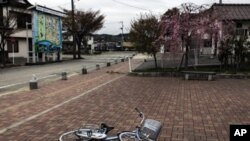The Japanese town of Minamisoma was hit hard by the earthquake and tsunami in March. The disaster killed several hundred residents. Tens of thousands were then forced to evacuate as reactors at the Fukushima Daiichi nuclear plant, which lies just 30 kilometers away, went into meltdown.
And many of the residents who remain feel they have been abandoned by the Japanese government.
Grass and wild rice are encroaching on the road leading into the Fukushima evacuation zone.
It is deserted apart from a single bus; on board are a few of the former residents of this area, now dressed in protective suits.
For three precious hours, they were allowed back to their homes. After collecting valuables, documents, even abandoned pets, they are once more escorted out.
A Japanese refugee, carrying a bouquet of flowers and wearing a suit to protect against radiation, boards a bus to take him to his home village of Namie to collect some of his belongings inside the nuclear contaminated exclusion zone, in Minamisoma, Japan, May 21, 2011. (AP).
Everyone living within 20 km of the Daiichi plant was forced to evacuate. For the next 10 kilometers, the government has simply recommended that people move away. The town of Minamisoma lies on the edge of that zone.
Determined to stay
Overgrown gardens and abandoned homes are testament to the exodus that followed the first explosion at the Fukushima plant. Almost overnight the population plummeted from 71,000 to just 10,000.
Nunokawa Yoshiuki is one of those who decided to stay. He’s still running his family’s fruit store, just 25 kilometers from the Fukushima Daiichi plant.
“There are six people in my family. If I run away, there would be no job for me," he explains. “I was born here, I grew up here; I work hard to treat my customers well. My roots are here and that’s connected to all my customers," adds Nunokawa. “I don’t want the Fukushima nuclear problem to beat us, I want to get over this, I talked to my family about it and I decided to stay here.”
Even though he’s decided to stay, Nunokawa fears for his business.
“The number of customers has really fallen,” he says. “I used to deliver to wholesale customers, but they are within the 20 kilometer evacuation zone, and have all closed down. So I’ve lost a lot of profit.”
Aftermath
A kilometer down the road. VOA found an abandoned farm. Behind the padlocked gates, rows of greenhouses full of dead plants. The cattle sheds overgrown and empty. The last entry on the delivery board at the farm entrance shows the date as March 13, two days after the tsunami hit.
At the town hall, officials are dealing with a stream of people asking for help and advice.
The mayor of Minamisoma, Sakurai Katsunobu, gained worldwide fame in March when he posted a video on the website YouTube, appealing for help.
He was scathing of the Japanese government’s response, saying his town was left "isolated."
Lingering fear
Five months on, authorities are struggling to bring the Fukushima nuclear plant under control. There is still much fear among the people of Minamisoma.
Takano Shinji is among the staff at the Tsunami Response Center.
“We get many phone calls from citizens looking for information," Takano says. "I can’t give them the answer, I have to ask the government, but always they say they haven’t made a decision yet. Always, the Japanese government’s answer is ‘No we can’t’.”
Hour by hour, town hall officials plot the latest radiation readings on maps and mark the progress made on the clean-up operation. Takano says for many years they lived in relative ignorance of the power plant.
“Before, we never thought about the nuclear plant just up the road,” he says. “The Japanese government always insisted that the plants were safe. But now with this situation that has befallen our town, we realize how dangerous nuclear plants really are.”
Latest readings suggest the current radiation level in Minamisoma does not pose a long-term health risk. But tens of thousands residents have abandoned this town. Many are unlikely to return.
Minamisoma has been changed forever thanks to its nuclear neighbor.











